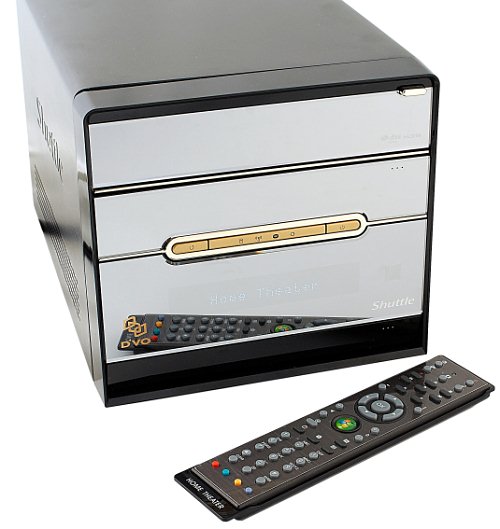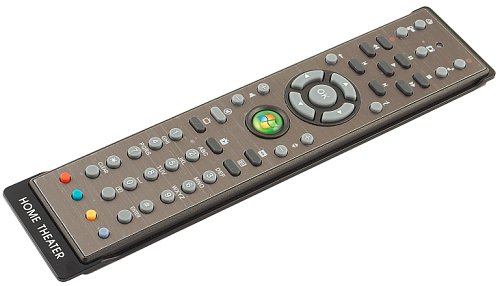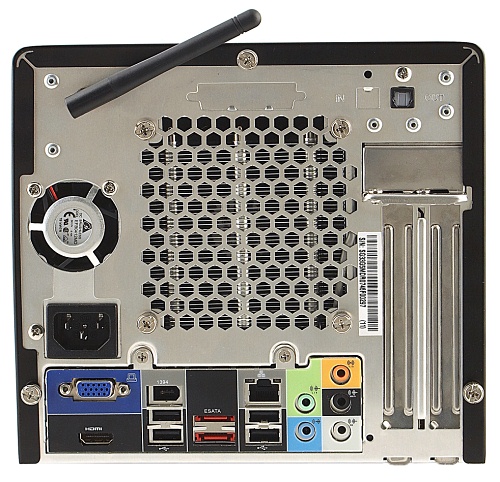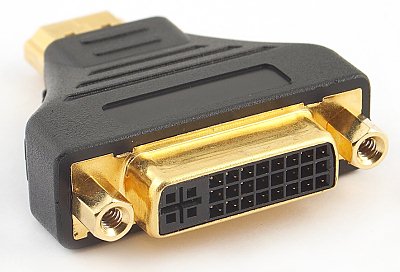 |
||
|
||
| ||
Shuttle has not updated its barebone product line much for almost a year and a half since our last review. But recently the company has launched a range of products based on new chipsets. At the same time, their marketing experts decided to divide the barebone family into several clearly positioned series. The XPC Prima series features gaming and workstation solutions and includes the new P2 chassis designed for intensive cooling and higher-end components. The majority of barebones now belongs to the XPC Glamor series, including the new G6 chassis, which we shall try to review in the nearest future. The third series now features barebones targeted at entertainment.  This entertainment series is called "D'VO," which stands for "Digital Visualize Opera". Essentially, it includes barebones in the familiar G5 case slightly modified, dubbed "G5M" and bundled with a remote control. Today we shall review the Shuttle SG33G5M Deluxe, see the changes introduced by the new enclosure and examine the peculiarities of D'VO series in general. ExteriorG5 chassis offers hinged lids on drive bays and interface connectors. The 5-inch bay cover is traditionally spring-loaded so that it opens when the CD/DVD-drive tray ejects and automatically closes after a disc is loaded. The case is made of aluminum (as always), and it's black (as most models). However, the plastic front panel of the G5M case is made of transparent plastic with a mirror substrate. Transparent plastic is necessary to show a special display inside. And the mirror helps preserve a uniform look of the front panel. The case has standard dimensions (for a Shuttle XPC) - 200x310x185 mm (WxDxH).  Along with an unusual front panel, Shuttle engineers also experimented with colors: they abandoned the usual combination of "black and silver" for "black and gold". It's a very good combination as well, but it's much harder to find a gold replacement than a silver one. As a result, a stripe in the center of the front panel with buttons and indicators is made of dull gold plastic, and a frame around it is made of light goldish metal. The same metal is used for the feet that can be screwed to the bottom of the case (in the fore part) to make the case fall back a little. Covers on the 3-inch external bay and on the group of connectors on the front panel are opened manually. Golden power and reset buttons as well as power/HDD/wireless(Wi-Fi and Bluetooth separately) activity indicators are located between them. The LEDs are so bright that they also ghost-light neighboring indicators. A set of interface connectors is typical for modern models: two standard audio jacks (microphone and headphones), 2 x USB, and 1 x mini-FireWire (4-pin, without power). They are all duplicated on the rear panel, which allows to use the front panel only for short-time connections (the case is not that attractive with open covers).  However, we can also see two unusual solutions (for such computers) here. Firstly, there is a fingerprint sensor on the left (on a flip lid) - it's quite a popular solution for notebooks, but not for desktops (at least when integrated into a chassis, not as a detachable unit). After installing corresponding software, you can identify yourself by scanning a finger instead of typing a password. The second interesting technology comes to life, when you press a button to the right of the fingerprint sensor. Control of the specified USB port on the front panel is given to a microcontroller, which allows to link two computers directly with a usual USB cable. The history of computers knows many other solutions, e.g. custom drivers to exchange files via an LPT link and industry-standard Ethernet LANs, FireWire cables. To say nothing of wireless networks (by the way, they may be too narrow for some scenarios.) Nevertheless, this USB connection may sometimes be more convenient (considering that a standard A-A USB cable is always present at home). Besides, it is free. However, it's not always true. Firstly, this solution does not offer sterling LAN emulation - you can transfer files only using special software (USB Speed-Link), which does not have the best interface. Secondly, the USB port on the front panel always works in the USB 1.1 mode (aka USB 2.0 Full Speed) for the reasons known only to Shuttle engineers (perhaps, it's required by the microcontroller). Besides, it's voltage is reduced, so you cannot plug most hard drives to this port (and flash drives). (By the way, Shuttle unofficially promotes technology to disable Speed-Link and return the USB port to its normal mode.)
The display on the front panel can show Windows Media Center information (it comes as part of Windows XP Media Center Edition and Windows Vista). For example, when you play music, it displays a track number, mode (playback/rewind/pause, etc), and time/duration. That is standard info, displayed by any media center. However, Shuttle offers more: along with its other features (low-level system monitoring, on-the-fly overclocking, fan speed control, etc), XPC Tools allows to display temperatures and fan speed from system sensors, system date and time, as well as custom text.  Windows Media Center is supported for a reason: according to Microsoft, this very application is the best tool to control a media center on a TV screen with a remote control. The SG33G5M Deluxe comes with a proper remote control in its bundle. It looks nice, although it's not very convenient to use: its buttons are too small and soft (to say nothing of feedback), so only a LED on the remote control will tell you that you actually pressed a button. However, it can do all it should, including putting a computer to sleep and waking it, starting Windows Media Center. You can watch our webcast that shows how one can control the SG33G5M Deluxe with the remote control. Besides, it contains short directions how to assemble this barebone kit and describes its features.  The rear panel looks like in most modern barebone kits, but the set of interface connectors has been revised (even compared to previous Shuttles). Firstly, this product has extended support for video output, as it's designed to be used in entertainment centers: a VGA output (analog) is supplemented with an HDMI (digital), which can be used as a DVI with the bundled adapter. Audio stream can be transmitted via HDMI or via five analog audio jacks (for 8-channel sound). You can also use S/PDIF. PS/2 ports are replaced with a couple of e-SATA ports. The product also offers 1xFireWire, 4xUSB, and 1xGigabit Ethernet. The motherboard allows to install a parallel port (LPT) and PS/2 ports in the middle of a rear panel (you'll have to buy this module separately). There is a small hole on the rear panel between the audio jacks and the room for expansion cards - as you may already know, it's used to access the CMOS reset button (very convenient to use).  Interior arrangement and functionalityThe G5M is practically no different from the G5 inside (except for the display mounted on the front panel), so our constant readers will find nothing new inside of the SG33G5M Deluxe. We should only pay attention to Wi-Fi and Bluetooth modules installed on the racks - they come with the standard bundle of the Deluxe product. As usual, to remove the lid from the SG33G5M chassis, you just have to unscrew three wing nuts on the rear panel, another two screws to pull out the drive cage, and four latches holding the front panel. Thus, it will take several seconds to get a system ready for assemblage and upgrades, almost without a screwdriver. The drive cage is quite standard, it can easily accommodate two hard drives or a hard drive and a card reader/floppy drive. Then it should be put back into place to proceed to CD/DVD drive installation in the upper bay afterwards. The cage is equipped with an isolating layer in the place where it may touch an expansion card, a convenient cable holder is attached to its bottom. Access to the 5-inch bay from within allows to align the extension mechanism of the eject button, if the corresponding button on the faceplate of a CD/DVD drive is not in its standard place. Besides, the standard knob of this lever can be replaced for a larger one, included into the bundle. A remarkable feature of G5 interior is a complete lack of cable jungle, so typical of the previous generations of Shuttle chassis. Interface connectors for the front panel are wisely laid out on the front edge of the board, connectors for S/PDIF cables and audio jacks, as well as a header for the CPU fan are placed at the back edge. Moreover, the barebone kit comes shipped with connected cables for hard drives, power cables from the PSU are wisely split and laid out along the racks (to the supposed usage location) and fixed with clips. In my opinion, the interior design of G5 is very good, a perfect match for the exterior. The SG33G5M uses the Shuttle FG33 motherboard based on the Intel G33 chipset. This motherboard offers the following functionality, provided by this chipset combination: support for Intel Pentium 4/D (only with 800 MHz and higher), Celeron 4xx, Celeron Dual-Core E1xxx, Pentium Dual-Core E2xxx, and Core 2 Duo/Quad (Socket 775) processors, up to 4 GB of DDR2-667/800 memory (there are only two DIMM slots on the motherboard) supporting dual-channel mode, integrated Intel GMA 3100, a PCIEx16 port for external graphics cards (when you use this port, HDMI output of the integrated graphics is disabled!), 3 x SATA-II (and 2 x e-SATA) not supporting RAID, 6 x USB 2.0, and 8-channel HDA. The integrated audio system is based on Realtek ALC888DD codec supporting the following technologies - DTS Neo:PC (expanding a usual stereo signal into 4-8 channels to create surround sound, if you have enough speakers connected), DTS Interactive (transferring encoded DTS signal to the external decoder via S/PDIF), Dolby Digital Live (encoding an audio stream into AC-3 "on the fly" to output it through S/PDIF) and digital output of PCM audio through S/PDIF. Besides, this motherboard contains controllers to support one UATA133 channel (for two devices), Texas Instruments TSB43AB22A, which provides two FireWire ports, and the Marvell 88E8056 network adapter (10/100/1000 Mbit/sec PCI-E Gigabit Ethernet). Barebone kits from Shuttle are traditionally equipped with one graphics slot (PCIEx16) and one PCI. The PCIEx16 slot is located closer to the edge of the board, which rules out graphics cards with bulky cooling systems. The motherboard also has CD-In and AUX-In, two fan headers (one of them is occupied). Shuttle FG33 offers decent overclocking features (specifying memory timings and frequency, FSB frequency, PCI-E frequency, CPU voltage, memory voltage, chipset voltage, and FSB voltage), which is common among modern barebone kits. The CPU voltage regulator uses only polymer capacitors, which is quite important for miniature power supply units: their owners rarely overclock them, but PC components inside small cases often suffer from high temperatures. Cooling system and temperature conditionsOverheating problems are solved with a cooling system of the barebone kit. Shuttle is true to itself, this company still uses one and a half cooling system in its XPC: ICE coolers for CPU and the system in general, and a Silent X PSU. Silent X is a series of power supply units from Shuttle featuring increased power capacity and an improved cooling system at a low noise level. This model uses a 300W PSU (the SG33G5M product is equipped with a 250W PSU) - no record is broken, of course, but we had absolutely no problems during our tests. Besides, the launch of processors based on the Core architecture solved the problem. Silent X PC50I3002 has two SATA power connectors, but it lacks a 6-pin connector for PCIE cards - perhaps, engineers were confident that users wouldn't use top graphics cards in this barebone kit. The power supply unit has a fan at each end for better ventilation of the PSU itself and the front part of the barebone kit. It uses Delta fans (EFB0412MD: 40x40x20 mm, 7.17 CFM, 24 dBA, very quiet, automatic fan speed control. As chipset bridges and field-effect transistors in the CPU power circuit are covered only with heat sinks, there are no other noise sources in the system. Shuttle SG33G5M uses the ICE system for cooling its CPU, traditional for all barebone kits from this company (the modification for G5/M chassis). It offers the standard principle of operation: a heat sink with an embedded copper plate at the base channels the heat from CPU via heat pipes to the upper heat sink, which is mounted at the grill on the rear panel. The upper heat sink is equipped with a powerful fan, which draws out hot air from the case and blows through the plate fins of this heat sink. The enlarged 92mm fan (Shuttle AD0912UX-A7BGL) singles out this system from competing solutions (and old Shuttle XPCs), because the noise/performance ratio of this cooler is outstanding. In our tests we failed to speed it up to being noisy.
The maximum ICE fan speed is ~3800 rpm, but as in all other Shuttle XPCs, the SG33G5M BIOS incorporates an automatic rpm control technology - Smart Fan. You can choose one of three modes: always maximum speed (you can adjust it with Windows utilities, including Shuttle XPC Tools and SpeedFan); ~900 rpm (Ultra-Low mode) until a certain temperature threshold is reached and then speed up to maximum, ~1550 rpm (Low mode), or ~2250 rpm (Mid mode); or Smart Fan. The latter is the most interesting mode, when rotational speed changes stepwise automatically: fan speed is minimal until a certain temperature (specified in BIOS, 25-75B°C) is reached (~950 rpm); after that each degree raises fan speed by 100-200 rpm. The system is inert enough not to jump from mode to mode incessantly (B±1B°C in a cycle). Besides, noise differences between neighboring modes are barely audible. As it's the first barebone kit with a Core 2 Duo processor that we have tested (it was possible to use a Pentium 4 in this case, but it wouldn't be interesting), we do not publish absolute temperature results - they make sense only in direct comparisons. Our constant readers may evaluate cooling efficiency, if they recall the situation with old models based on the G5 chassis - it's apparently on the same level in the G5M. Shuttle barebone kits in G5/G5M chassis are the quietest products in their class in Smart Fan mode, which provides sufficient cooling for all system components. Bundle and brief specification of the barebone kitShuttle usually offers a lot of accessories for most of its products to be bought separately, trying to keep retail prices lower. But in this case, the bundle is expanded, considering that it's a Deluxe edition: pre-installed wireless modules, a remote control. The bundle also includes all accessories to facilitate assemblage, of course: cable clips, strips of insulation mylar to fix the cables on case racks, screws, thermal paste, etc. In conclusion we provide a brief specification of the barebone kit, which comes shipped in a nice cardboard box with a handle.
Performance testsWe haven't seen significant performance differences between motherboards on the same chipset for a long time already. We could have omitted this chapter, because it's similar to that for other motherboards on G33 and i965 chipsets. The only thing worth mentioning is test results of the integrated graphics in games - not relative, but absolute values. Testbed configuration
Our comparison of two motherboards in archiving performance just proves our similarity assumption. Doom 3 is quite an old game with a modern engine. Unfortunately, integrated graphics in the Shuttle FG33 will not provide comfortable speed even with minimum graphics settings. You could use GMA 3100 to play older FarCry (although open-field scenes with many objects may easily drop fps from 80 to 30), but only at the lowest resolutions and with barely acceptable graphics quality. ConclusionThe SG33G5M Deluxe deserves the same compliments and remarks as usual barebone kits from Shuttle in the G5 chassis. We can mention the excellent chassis (both in design and usability terms) that provides comfortable thermal conditions with a minimal noise level; support for all top processors (but not graphics cards); rich video and audio output options (including dual monitors); pre-installed wireless modules; fingerprint sensor. Unfortunately, drawbacks have grown proportionally - the main (and only) problem with barebone kits from Shuttle is their price: the Deluxe edition of this product was about $500 at the time of this article. However, don't forget about multiple advantages of the SG33G5M Deluxe. In fact, when you buy this product, you will get (after buying a CPU, memory, and optional graphics and expansion cards) a ready entertainment center built on interchangeable desktop components with a bundled remote control and a case display, which are already configured for Windows Media Center. Many users will be satisfied with this flexibility. Besides, rich functionality of this product partially makes up for its high price. If you buy a competing product, you will have to buy additional accessories to obtain such functions. Anyway, this product gets our Original Design award. We award the G5M chassis in general (not just the SG33G5M Deluxe), so there is no need to mention all similar products from Shuttle again and again.  In conclusion we'll publish a short list of the most typical pros and cons of the barebone kit under review. Pros
Cons
Official product pages: SG33G5M Deluxe, SG33G5M. Sergey Pikalov (peek@ixbt.com)
March 27, 2008 Write a comment below. No registration needed!
|
Platform · Video · Multimedia · Mobile · Other || About us & Privacy policy · Twitter · Facebook Copyright © Byrds Research & Publishing, Ltd., 1997–2011. All rights reserved. |